Different Fielding Positions in Cricket Ground
Do you always feel disconnected and agitated while listening TECHNICAL TERMS from commentators or cricket fans in your family or friend circle ? I am damn sure you too want to impress them with your cricketing knowledge and and have long conversations on it. So why not start with some of the most important concepts in fielding .Today I will be giving you the detailed explanation about different fielding positions in cricket ground.
This blog is purely for passionate cricket lovers and beginners who want to dive deep into the world of cricket and enjoy it more than ever before . These names of different fielding position in cricket will be important for :
- The ones who want to enhance their knowledge about cricket and start watching and playing cricket more passionately and wisely .
- All the budding professional cricketers . You must know all rules and terms related to cricket . It’s the foremost trait for any professional cricketer , whether it’s relevant for you at that point or not . It becomes even more essential for you if you want to become the captain of your team in future .
Before we jump to various fielding positions in cricket ground, I would like to introduce some basic points about fielding and cricket field to newbies and make them familiar with the common terms .
Meaning of Fielding and Fielding Positions in Cricket
- After bowler delivers the ball from one end to the batter and the batter strikes it accordingly to score runs , then comes the role of a fielder . There are 11 fielders in one side including bowler and the wicket-keeper . Fielders basically have to assist their bowlers by :
- Stopping runs and making harder for the batters to score runs either by running between the wickets or hitting boundaries .
- Taking catches and doing run outs for dismissing the batters .
These actions of all fielders taking catches , stopping runs , doing runs altogether is known as fielding . It is one of the three most important skills in cricket after batting and bowling .
As you know how big is a cricket ground , therefore there are numerous positions in which fielders can be placed to stop runs . The positions in which the fielders are finally placed before the ball is delivered are known as fielding positions in cricket ground .
You cannot always scream and direct your fellow team players through your gestures to change their positions from one to another . Directing your fielder to the desired position can become frustrating . That is why every possible fielding position in a cricket field has been given a name to reduce time and energy for placing a fielder .
Fielders are positioned primarily according to the tactics and strategies planned by the team against a particular batter . But the final decision lies with the captain of the team only . It becomes very convenient for the captain and the bowler to place his fielder by just communicating the name of the fielding position to him .
Information about Cricket Ground/Field
- Mostly , cricket is played in a circular or oval ground . There is a 22-yard (20 meter) long rectangular pitch at the center of the cricket field . There are no specified dimensions of a cricket field . But it has an “inner circle” marked by an oval of 30 yards from the center of the wicket . It divides the field into an infield and outfield .
- At both the ends of the pitch , there are wickets comprising two bails resting over three stumps .
- The whole circular cricket ground is divided into two halves i.e. Off-side and Leg-side (On-side). The right of a right-handed batter is known as off-side and his left is known as leg-side and vice-versa for a lefty .
- A cricket field is broadly divided into three major fielding regions for fielders i.e. CLOSE-INFIELD , INFIELD AND OUTFIELD
INFIELD FIELDING POSITIONS IN CRICKET
Cricket Field has an “inner circle” marked by an oval of 30 yards from the center of the wicket . It divides the field into an infield and outfield which you can see in the diagram above . Therefore the region inside that circle is known as Infield .
CATCHING OR CLOSE INFIELD FIELDING POSITIONS IN CRICKET

Close Infield is the ” 8 shaped ” region inside the 30 yard circle as shown in the diagram above . These fielding positions in cricket which have main purpose of only catching the ball and dismissing the batter are known as catching positions in cricket . These positions are not intended to stop any sort of runs . Their main motive is to get placed in such locations where the ball is more likely to go up .
- Catching positions examples are slips , gully , short mid off , short mid on , short cover/extra cover , short mid wicket etc. They have good distance from the batter and time too for reacting to the ball .
- These positions are also called silly positions as fielding so close to the batter is evidently a silly choice . These positions are just at a distance of 2-3 steps from the batter . Therefore , fielders are required to wear all the protective gear while fielding like helmet , pads etc. Examples are silly point, short leg , silly mid-off / mid-on .
- Since these positions are so close to the batter , they are expected to grab the ball only from the edges of bat or which is carrying less speed .
- Formation of the names of catching positions is also done by adjusting the foundational names of all the infield positions . Otherwise , it would have been very difficult to remember all the names . So prefix words like short , silly are only added to the original position names which are in line with the catching positions . This makes their names less complicated and easy to learn .
- Some of the key players who became successful in these positions are Ian Bell , Eknath Solkar , Younus Khan , Tom Latham etc.
OUTFIELD FIELDING POSITIONS IN CRICKET
The fielding positions which are outside the 30 yard in inner circle are known as OUTFIELD FIELDING POSITION IN CRICKET .
These positions on the boundary are basically the extensions of the primary fielding positions at the inner circle which we discussed above . The ideal requirements too will be almost similar for all the outfield positions .
Diagram of a Cricket Ground / Cricketer’s Chart
All the fielding positions in this blog will be covered according to the right-hand batter . Therefore , these positions will be exactly opposite/vice-versa for a left-handed batter .
All Fielding Positions in Cricket Ground
- Moving anti-clockwise , we will discuss each fielding position and take full 360 degrees view from off-side to leg-side . But before other positions , let’s start with our most important fielder i.e. wicket-keeper .
1. WICKET-KEEPER

- Wicket-keepers are considered the soul of the fielding side . He/she cannot be considered a fielder on off-side nor on leg-side as he has to stand (or crouch) just behind the wickets . This allows him to stump or run-out the batter and knock the bails out as soon as the batter steps out of the crease to play the ball .
- Most of the wicket-keeper dismissals come when they take catches of batter’s inner and outer edges .
- He is in the best position to guide the captain as well as the bowler for the best fielding placement . Also , his observations of the pitch become very important for the bowlers for adjusting their line and length .
- Usually standing so close to the batters , he continuously sledges and find ways to shatter their concentration .
- His role of uplifting the morale of team and bowlers becomes very crucial in tough periods .
- There have been many legendary wicket-keepers like Kumar Sangakkara , Adam Gilchrist , MS Dhoni etc.
2. SLIP AND GULLY

- Starting from the immediate right and left of the wicket-keeper , there is a slip and gully on both off and leg-side .
- There can be as many consecutive slips and gullies as the captain or team wants on off-side .
- These fielders are placed behind the batter’s end forming a curve or a semicircle .
- When there is a little gap between two consecutive fielders , they are considered as SLIP fielders . And when there are big gaps between two consecutive fielders , they are considered as GULLY fielders . This group of slip and gully fielders is also known as SLIP CORDON .
- Usually , in test matches , there are 3-4 slips and a gully next to wicket-keeper on off-side . A LEG SLIP or GULLY is placed rarely in the match .
- There is also a FLY SLIP which stands between the slip cordon and the third man . It is one of the rarest positions in cricket . i.e. it is an uncoventional fielding positions in cricket .
- Because of higher speeds of fast bowlers , slips along with wicket-keeper stand far behind the wicket . While they stand much closer to the wicket when a spinner is bowling .
- Usually batters stand at slips due to their good hand-eye coordination and good concentration on the ball. Examples are Rahul Dravid , VVS Laxman , Steve Smith , Alastair Cook, Ajinkya Rahane , Joe Root etc.
3. (SHORT) THIRD-MAN

- Third man is a position which can be placed on the inner circle as well as the boundary of the cricket field.
- It can be placed anywhere behind the wide range from gullies and slips to wicket-keeper . Third man is always facing the back of the batter or the batting wicket .
- Imagining third slip as mid-point , draw a straight line from the batting wicket to the inner circle , the endpoint on the circle is your SHORT THIRD MAN .
- If you move your third-man towards your wicket-keeper , you are making it finer and he is called FINE THIRD MAN . And if you are moving him in the opposite direction , he will be called WIDE or SQUARE THIRD MAN.
- Usually , ball travels to third-man when :
- ball takes the outside edge of the bat when it is new and swinging or
- batters try to strike the ball very hard and lose the shape , then ball takes the outside edge
- the batter plays the ball very late and guides the ball to third-man for a single
(DEEP) THIRD MAN
- If you will extend the straight line of third man and batting wicket to the boundary , that fielder will be known as THIRD MAN or DEEP THIRD MAN.
- Fielding in outfield always require fast runners . That is why you will see usually fast bowlers stand at third man . It also helps them warming up their bodies for their next overs from the same end .
- Ravichandran Ashwin , Josh Hzalewood , Jasprit Bumrah are one of the common faces seen on third-man .
4. POINT
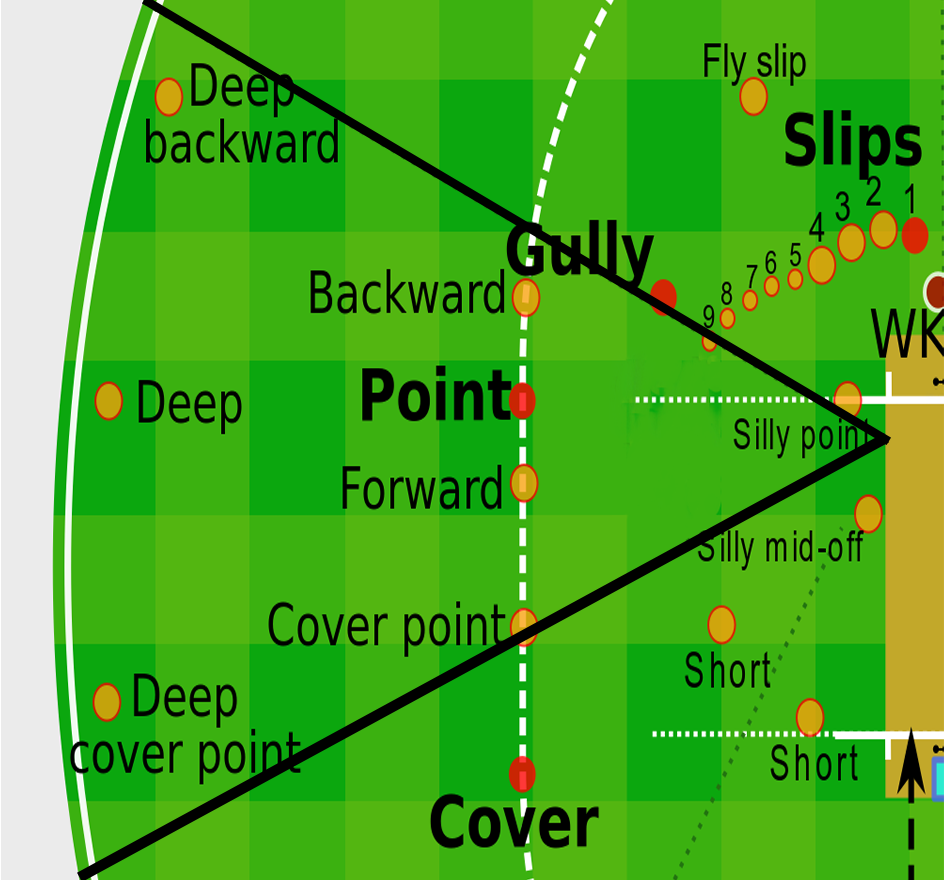
- Next place to third-man is POINT . Point fielder is placed in line with the batting wicket (or opposite to square-leg umpire ) at the inner circle .
- Point is considered as the most challenging and toughest fielding position in cricket field . Generally the quickest and most agile player of the team stands there .
- Ball travels at relatively higher speeds at point as compared to other positions . Because of this , you get very little reaction time .
- Mostly , ball comes to point fielder when batter plays shots like square cut or drive , late cut , back-foot drive and in some cases reverse sweep too .
- If we shift the point fielder slightly towards third man , the position is known as BACKWARD POINT . And when you shift him towards the bowler end , he is known as FORWARD POINT .
- Some fielders have made their names only by fielding at this position and single-handedly winning matches foe their team . Some of them are Jonty Rhodes , Mohammad Kaif , Yuvraj Singh , Ravindra Jadeja ,Glenn Maxwell etc.
SILLY POINT
If we move POINT that close to the batter in a straight line , it is known as SILLY POINT .
As you know it’s parent position is Point . Like fielders could be placed at backward or forward point , similarly one could be placed at BACKWARD or FORWARD SILLY POINT .
DEEP POINT
It is the extension of POINT at the boundary . If we move it towards third-man , it is known as DEEP BACKWARD POINT .
Some of the popular fielders at deep point are Umesh Yadav , Yuzvendra Chahal etc.
5. COVER / EXTRA COVER
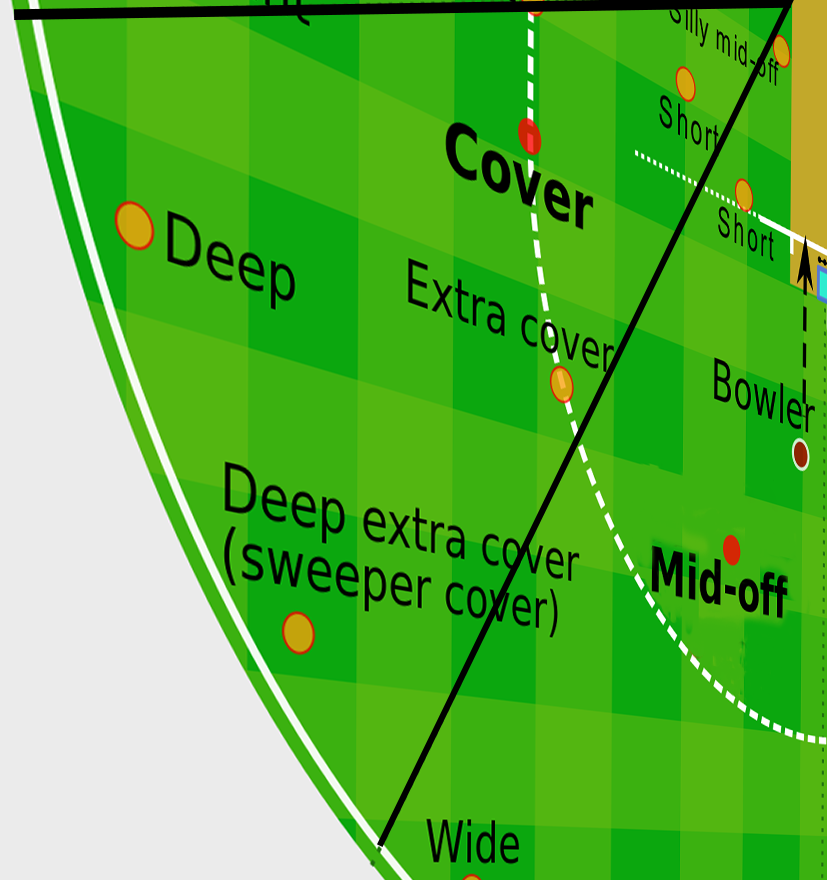
- After point , comes the COVER fielder, in terms of position as well as its importance .
- It is one of the most busiest fielding position in cricket field , especially while the ball is new . Because with new ball , bowler bowls at driving length outside off-stump trying to find swing . And batters keep on pushing or driving the ball through cover and extra-cover .
- Both back-foot and front-foot cover or extra-cover drives are bread and butter shots for the majority of the batters against spinners and fast-bowlers . That is why you need one of your best fielders to field there . You also get lot of catching opportunities there .
- If you move your cover fielder to point fielder , he will be known as COVER POINT . And if you move him in opposite direction , he will be known as EXTRA COVER .
- Examples will be Rohit Sharma , Suresh Raina , Brendon McCullum etc.
SHORT COVER / EXTRA COVER
- You can put your fielders forward in catching positions at covers if :
- you want to be bit more attacking and want to take wickets as a captain
- your team plan is to bowl outside off-stump and force the batter to drive through covers
- They just come closer to the batters in the same line as the cover . These fielders are known as SHORT COVER.
- Like we have cover point and extra cover , similarly there is SHORT COVER POINT AND SHORT EXTRA COVER too .
- Since we have shortened the distance between the batter and fielder , the fielder has to be ready for higher force and speed on the ball .
- There will be less reaction time . So you need to increase your concentration and speed of your body movements to successfully catch balls at such speeds .
- Some of the common fielders at this position are Virat Kohli , Kane Williamson , Steve Smith etc.
DEEP COVER ( COVER SWEEPER ) / EXTRA COVER
Deep Cover is simply the extension of COVER at the boundary .
Like covers , deep covers has other sub-positions like DEEP COVER POINT AND DEEP EXTRA COVER (COVER SWEEPER) .
Frankly , captains do not have to think too much before placing any fielder in this position . Any average fielder can field here comfortably
6. MID-OFF AND MID-ON
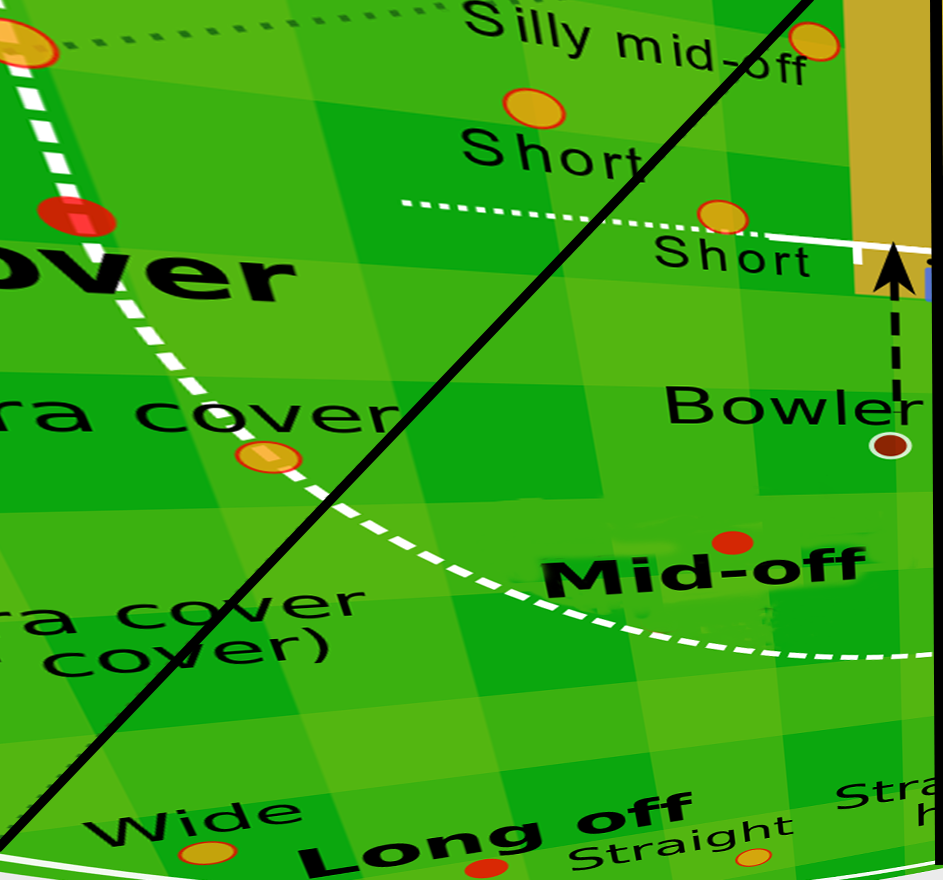
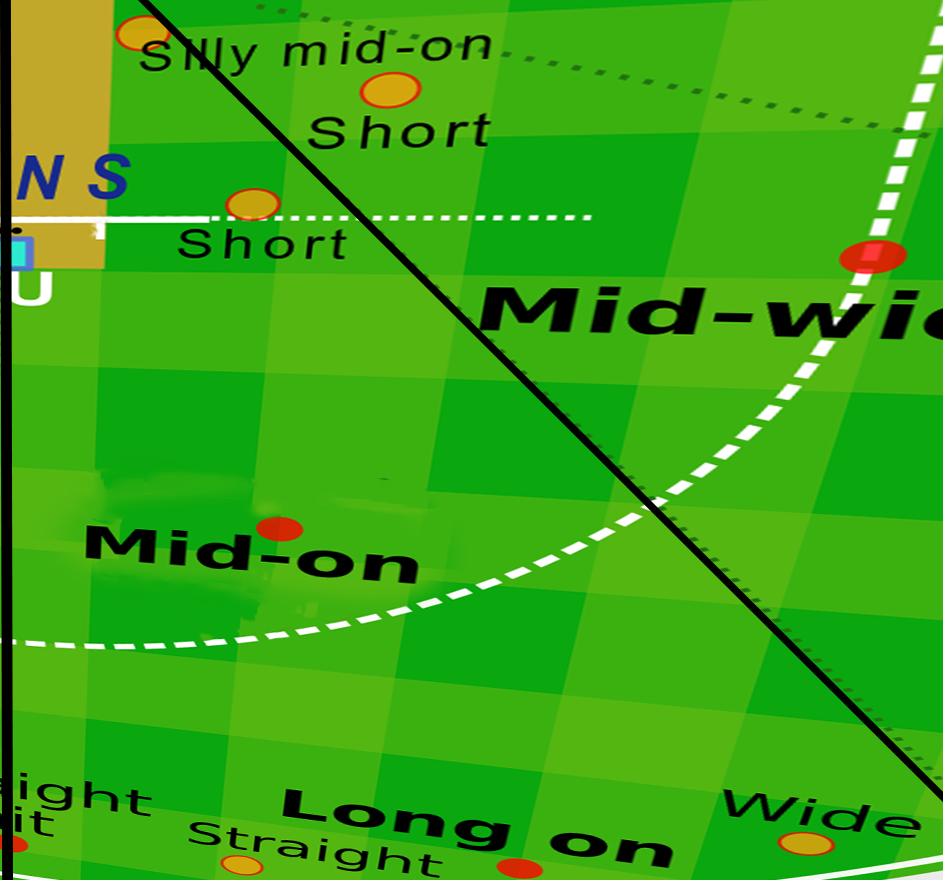
- After the covers positions , we come to the straighter positions i.e. MID-OFF AND MID-ON . Mid-off region is left to the pitch while mid-on is on its right . As the name suggests mid-off lies in off-side while mid-on in leg- side ( on-side ) .
- They are placed on the inner circle behind the non-striker’s end and in front of the striker’s end .
- The region covered by these two positions is also known as ” V- region “ for batters . You must have heard many coaches giving you batting tips to play in V . It is because you will have to play shots with full phase of the bat if you want to score runs in front of the wicket which reduce the chances of getting you out .
- Usually , ball travels to the “V-region” when batters play backfoot or frontfoot off , straight and on-drive .
SHORT MID-OFF AND SHORT MID-ON
- You place short mid-off or mid-on if :
- your plan is to make the batter out by over-pitching the ball and making him play off or on drive
- you think that the pitch has uneven bounce and the ball can go up in air when batter drives the ball
- Like short cover , SHORT MID-OFF or MID-ON are also positioned in the same line with mid-off and mid-on . They just come close to the batter standing near the NON-STRIKER’S END in catching positions .
- Short mid-off left to the wicket and mid-on to it’s right .
- It means the fielder has only 22 yards and very less time for reacting to the ball . Ball travels really fast to these catching positions and you need to be very skillful fielder to take such sharp catches .
SILLY MID-OFF
It is the catching position in the same direction of mid-off .
SILLY MID-ON
The catching position in straight line to the mid-on is known as SILLY MID ON .
LONG-OFF AND LONG-ON
- They simply are the extensions of MID-OFF AND MID-ON at the boundary .
- If you move long-off towards covers , then it is known as wide long-off and if you make it straighter moving it slightly behind the wickets , then it is straight long-off .
- Similarly , if you move long-on towards mid-wicket , then it is known as wide long-off and if you make it straighter moving it slightly behind the wickets , then it is straight long-on .
- Usually , tall fielders are placed here at the slog (death or end ) overs of the innings . Their extra reach can sometimes play a crucial role in converting a six into wicket . But it becomes a very tiring job sometimes when you have to run end to end in each over . You need to be on your toes when fielding on long-off/on during the last overs .
- Examples of some amazing fielders at long-off / on are Kieron Pollard , Faf Du Plesis , AB de Villiers etc.
7. MID-WICKET

- It will be our second position after mid-on on the leg-side. Moving anticlockwise , Mid-wicket is the next fielder to mid-on .
- Generally , he is placed on the circle just opposite to or in straight line with the extra cover and non-striker’s wicket . It is one of the most crucial position where a quick fielder is neede to catch sharp catches as well as stop quick singles .
- You can adjust the mid-wicket fielder to his left or right as per your convenience . The name remains the same for it .
- The ball goes to the mid-wicket fielder when batters either play on-drive , flick or pull .
SHORT MID-WICKET
- If the fielder is brought up more closer to the batter from the same line of mid-wicket in a catching position , the position is known as SHORT MID-WICKET .
- Captains usually place this fielder when :
- the bowl is reverse swinging and fast bowlers have a strategy to bowl on stump line and make the batter play shots like flick in air
- an off-spinner is bowling and you want the batter to fall in the trap and give catch straight into his hands
- you want to stop the batter from taking singles and doubles
Deep Mid-Wicket / Sweeper / Cow Corner in Cricket
It is the extension of MID-WICKET at the boundary . It is the main scoring area for majority of the batters in death overs . Normally , it is the natural stroke of any big-hitter . So , a good fielder is required here too .
The area or position between long-on and deep mid-wicket is also known as COW CORNER OR DEEP FORWARD MID-WICKET .
Examples are Glenn Maxwell , Ravindra Jadeja etc.
8. SQUARE LEG
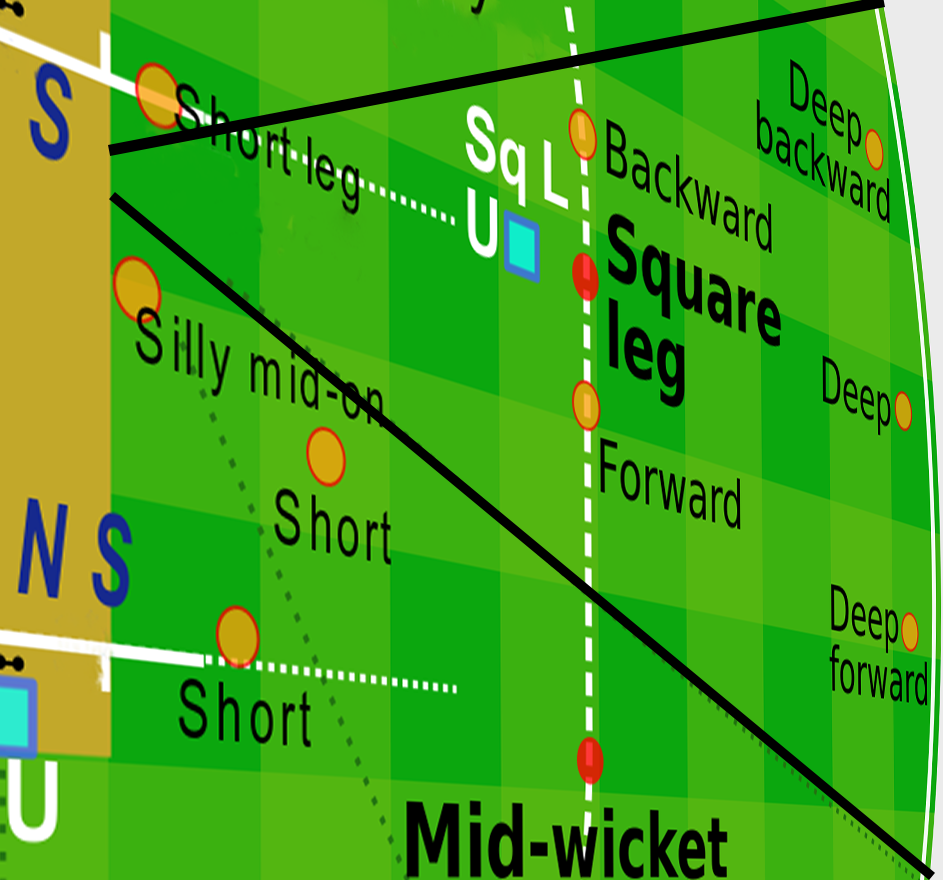
- Next fielder to mid-wicket is known as SQUARE-LEG . Conventionally , square-leg fielder is placed exactly near the square leg umpire .
- If he is placed to the right of the umpire , the position is BACKWARD SQUARE LEG . And when placed to umpire’s left side , position is FORWARD SQUARE LEG .
- Ball travels here majorly when batters play shots like pull, hook , leg glance , flick etc.
NOTE : YOU CAN PLACE ONLY TWO FIELDERS IN THE REGION COVERED BY SQUARE LEG UMPIRE AND THE WICKET-KEEPER . THAT IS WHY YOU CANNOT PLACE MORE THAN TWO SLIPS OR ONE SLIP AND GULLY IN LEG-SIDE .
SHORT-LEG
SHORT LEG is the catching position near the batter in the same direction and line of the square leg .
Similar to square leg , there can be BACKWARD SHORT LEG as well as FORWARD SHORT LEG .
DEEP SQUARE LEG
It is the extension of SQUARE LEG at the boundary . Fast fielders with good throwing arm are required here too .
Deep square leg can also be shifted to DEEP BACKWARD SQUARE LEG or DEEP FORWARD SQUARE LEG .
Examples are Shikhar Dhawan , Tim Southee etc.
9. (SHORT) FINE LEG
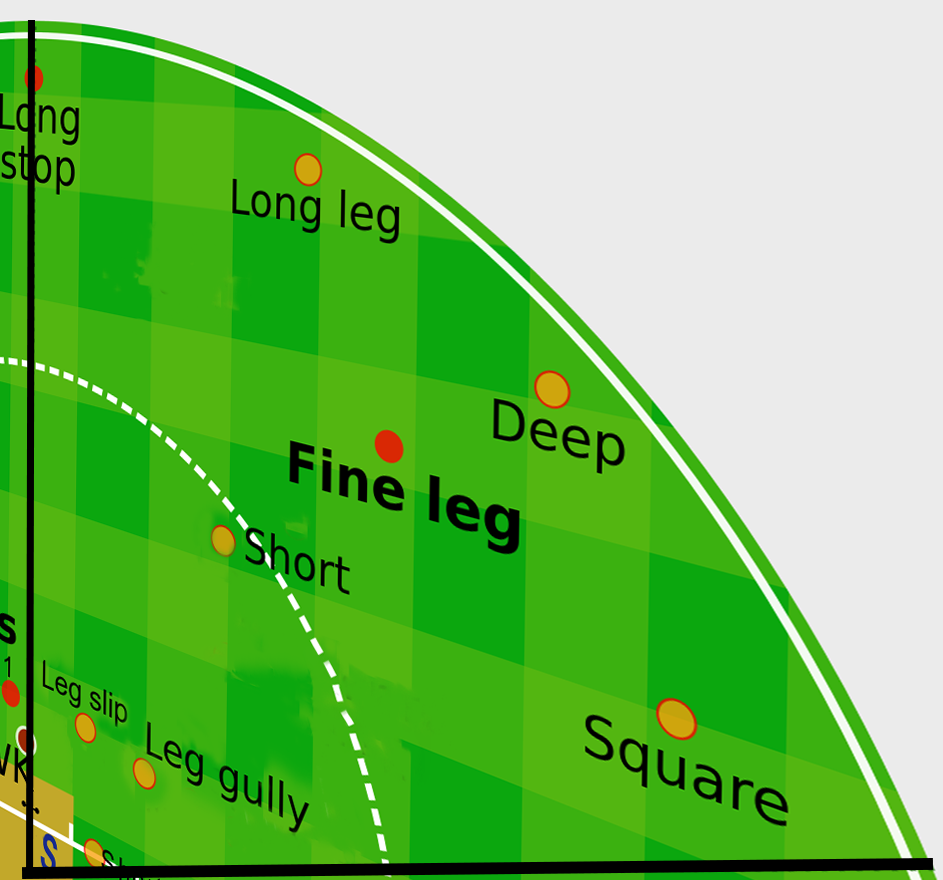
- So our last position in leg-side is FINE-LEG , next to square-leg on the inner circle .
- Like mid-off and mid-on are mirror images of themselves , fine-leg is the mirror image of third-man but on leg-side .
- Fine-leg is behind the batting end and so see the batters from behind .
- If you move fine-leg more behind the wicket , you are making it straighter and it is called STRAIGHT FINE LEG . And if you move it towards the square leg , it is known as SQUARE FINE LEG .
- Usually , ball travels to fine-leg when batters play leg glance , paddle sweep, sweep , pull or hook shot , paddle scoop ( or Dilscoop ) .
DEEP FINE LEG
DEEP FINE LEG is the extension of (SHORT) FINE LEG at the boundary . You can afford to place one of your weak fielders here. Usually , fast bowlers field here too .
If you make your fine leg straighter or more finer , the fielder is known as LONG LEG . And if you move it towards the square-leg it will be known as DEEP SQUARE FINE LEG .
Examples are Mohammad Shami , Trent Boult , Mitchell Starc , Kagiso Rabada etc.
10. LONG-STOP AND STRAIGHT HIT
- LONG-STOP is the fielding position exactly behind the batting wicket or striker’s end on the boundary . Similarly, STRAIGHT HIT is the fielding position in front of the batting wicket ( or behind the non-striker’s end ) on the boundary .
- These positions are rarely used in any form or level of cricket . These positions are unconventional and of little use for the most of the time .
2 Comments
Leave a Reply
You must be logged in to post a comment.

Hi, brother this website is very nice and i learn many things about cricket fielding, bowling, keeping, batting and this website is on God level 👍🏻❣️😊
Thanks a lot brother… Very happy to hear that . I would love to help you guys like this in future too . You can also suggest me any topic on which you want a blog.